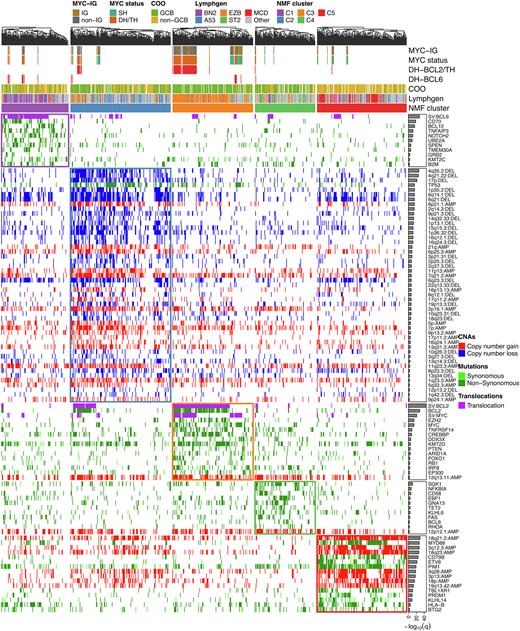Abstract
Introduction High grade B-cell lymphoma with MYC and BCL2 and/or BCL6 translocations (HGBL-double hit (DH)/-triple hit (TH) is the most strictly defined molecular class of diffuse large B-cell lymphoma (DLBCL) and is characterized by MYC plus BCL2 rearrangements with- or without BCL6 rearrangement. HGBL DH/TH have an inferior prognosis under standard DLBCL treatment compared to patients without MYC-rearrangements and currently few effective second-line options exist. Still, some HGBL DH/TH respond well to treatment, highlighting the need for further refined markers predictive of treatment resistance and relapse.
To distinguish different DLBCL subtypes, two independent DNA based classifications were proposed by the Dana Farber Cancer institute (DFCI) and the National Cancer Institute (NCI, Lymphgen), that distinguish 5- and 7 DLBCL subtypes, respectively. These subtypes are characterized by distinct pathological mechanisms and outcomes. However, in both classifications the number of MYC rearranged cases was insufficient to accurately determine the position of MYC rearrangements in the genomic landscape of DLBCL.
We collected a large DLBCL genomic dataset enriched for MYC rearranged cases to evaluate the hypothesis that HGBL DH/TH, or subsets of HGBL DH/TH define a separate molecular class.
Methods High quality next generation sequencing (NGS) data for i) mutations, ii) genome-wide chromosomal copy numbers, and iii) MYC, BCL2 and BCL6 rearrangements was assembled for a set of N=706 DLBCL samples from 4 study cohorts (HOVON-84, HOVON-130, PETAL trials and the DFCI dataset) that included N=102 cases with MYC rearrangements including single-hit (SH), HGBL DH and TH. All samples were assigned to genomic subtypes according to published algorithms.
Results Clustering all samples following the DFCI approach identified 5 clusters in concordance with published results (Figure 1). We find that MYC SH cases (N=36) are scattered throughout the 5 DFCI subtypes, while the majority of HGBL DH-BCL2/TH cases (N=41/50) fall together in subtype C3, a germinal center B-cell (GCB) rich subtype. Inspection of the genetic features of this HGBL and GCB rich subtype shows that it has many of the genetic characteristics corresponding to transformed follicular lymphomas. DH-BCL6 cases were few (N=16) and predominantly clustered in C1.
When classifying samples according to Lymphgen, again we find that the MYC SH cases are scattered throughout the 7 subtypes, while HGBL-DH/TH with BCL2 rearrangement are classified as EZB (N=40/50), substantiating earlier interpretations. DH-BCL6 cases were mostly classified as BN2.
Conclusion We recapitulate the 2 DNA-classification methods with a data set enriched for MYC rearranged cases (102/706 samples) and demonstrate that HGBL DH-BCL2/TH form a sub-cluster within DFCIs C3, and Lymphgen's EZB respectively, with genomic characteristics of transformed follicular lymphoma. DH-BCL6 cases were few, but come together in both classifications, DFCI C1 and Lymphgen BN2, consistent with the WHO-HAEM5, in which DH-BCL6 is classified as a separate subtype. MYC SH are not assigned to a specific subtype, also consistent with the WHO-HAEM5.
These results provide the currently most robust molecular basis for stratification of DLBCL cases with MYC rearrangement.
Figure 1. Cluster heatmap of 706 DLBCLs of which 102 have MYC rearrangements. Clustering was performed by non-negative matrix factorization (NMF) according to DFCI. Top: Classification of samples according to MYC status, Lymphgen assignment, and cell of origin (COO). Right: Genomic alterations (copy number alterations, CNAs; mutations and translocations) enriched in NMF clusters C1 to C5.
Disclosures
Van Dijk:Novartis: Consultancy. Kersten:BMS/Celgene: Honoraria, Research Funding; Kite, a Gilead Company: Honoraria, Research Funding; Miltenyi Biotech: Honoraria; Novartis: Honoraria; Roche: Honoraria, Research Funding; Takeda: Honoraria; Adicet Bio: Honoraria. Chamuleau:Roche: Honoraria; Genmab: Research Funding; BMS/Celgene: Honoraria, Research Funding; Gilead: Research Funding; Abbvie: Honoraria; Novartis: Honoraria.
Author notes
Asterisk with author names denotes non-ASH members.


This feature is available to Subscribers Only
Sign In or Create an Account Close Modal